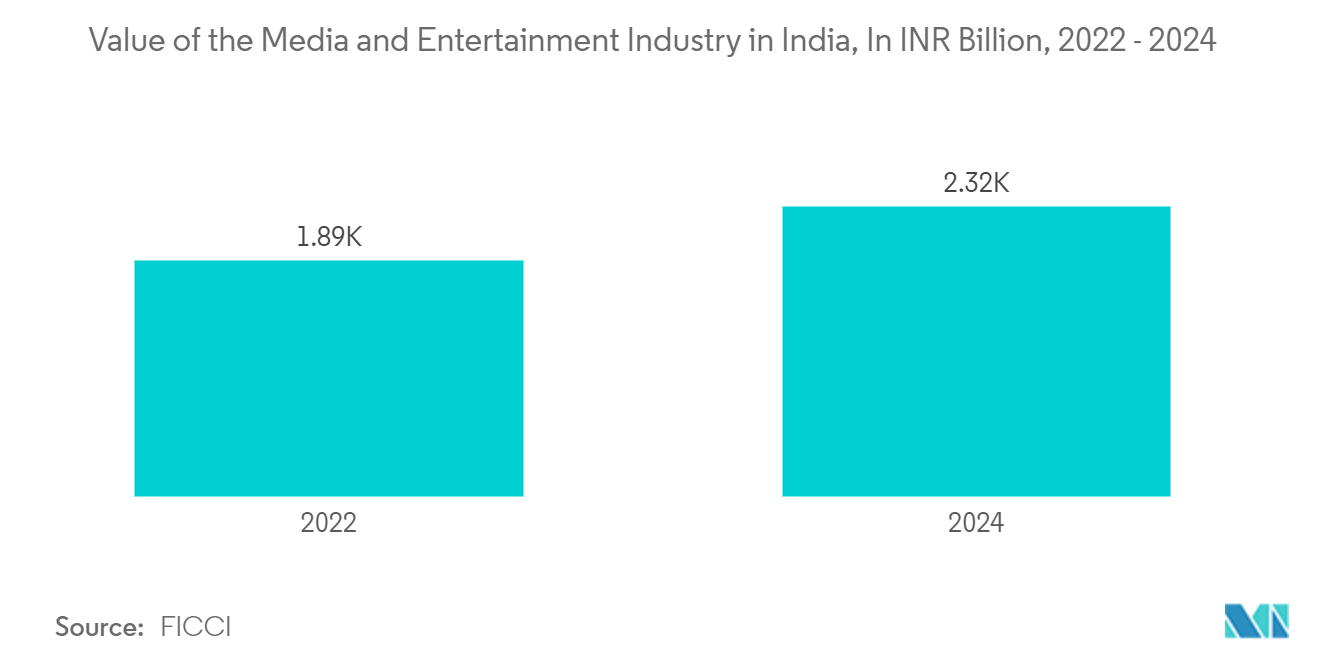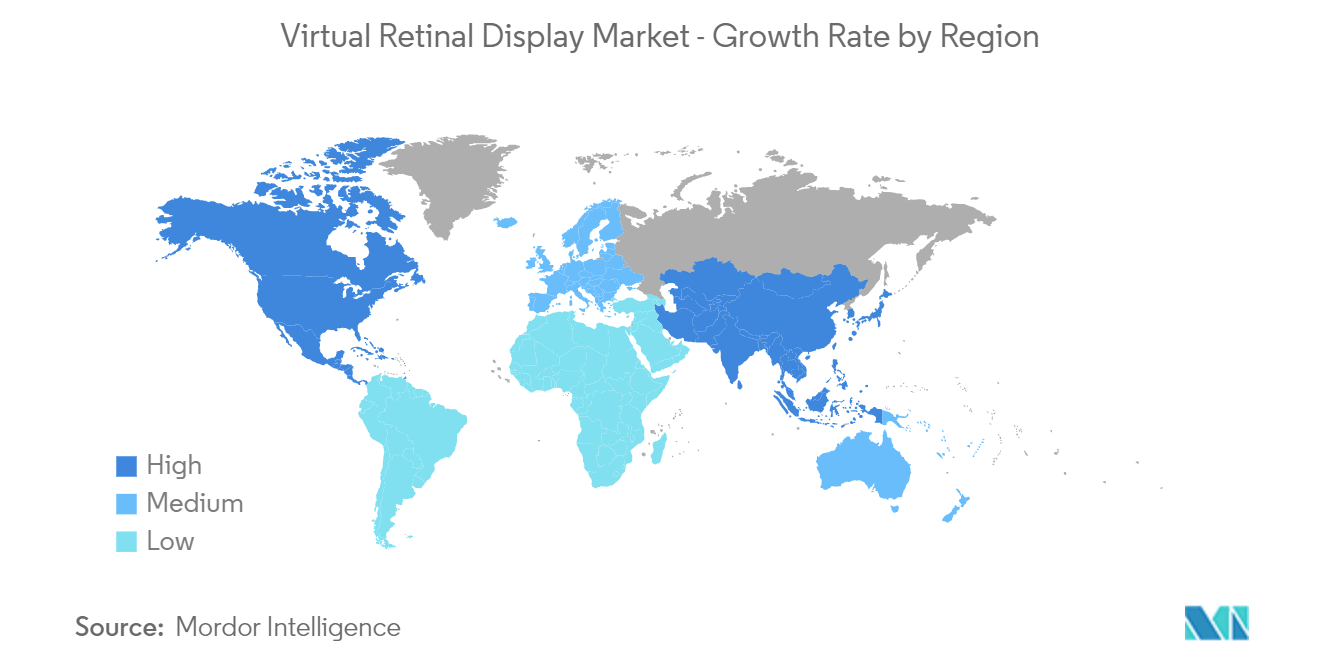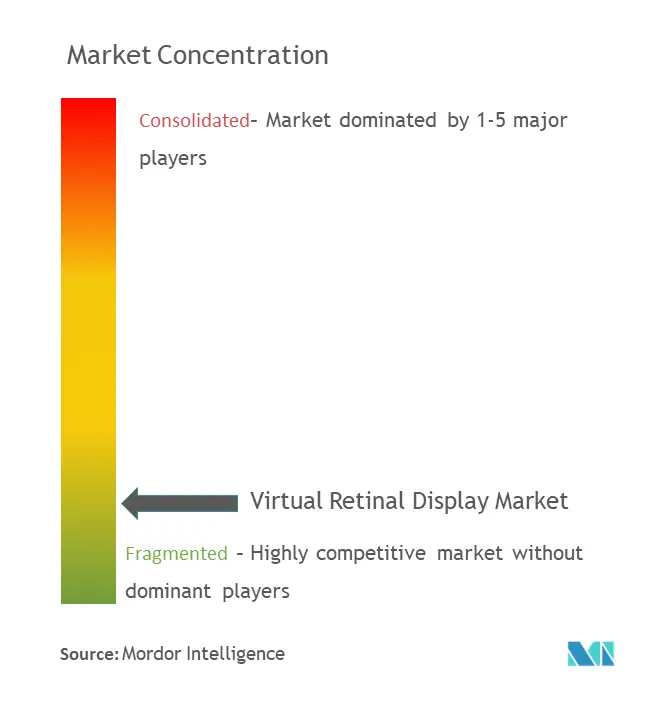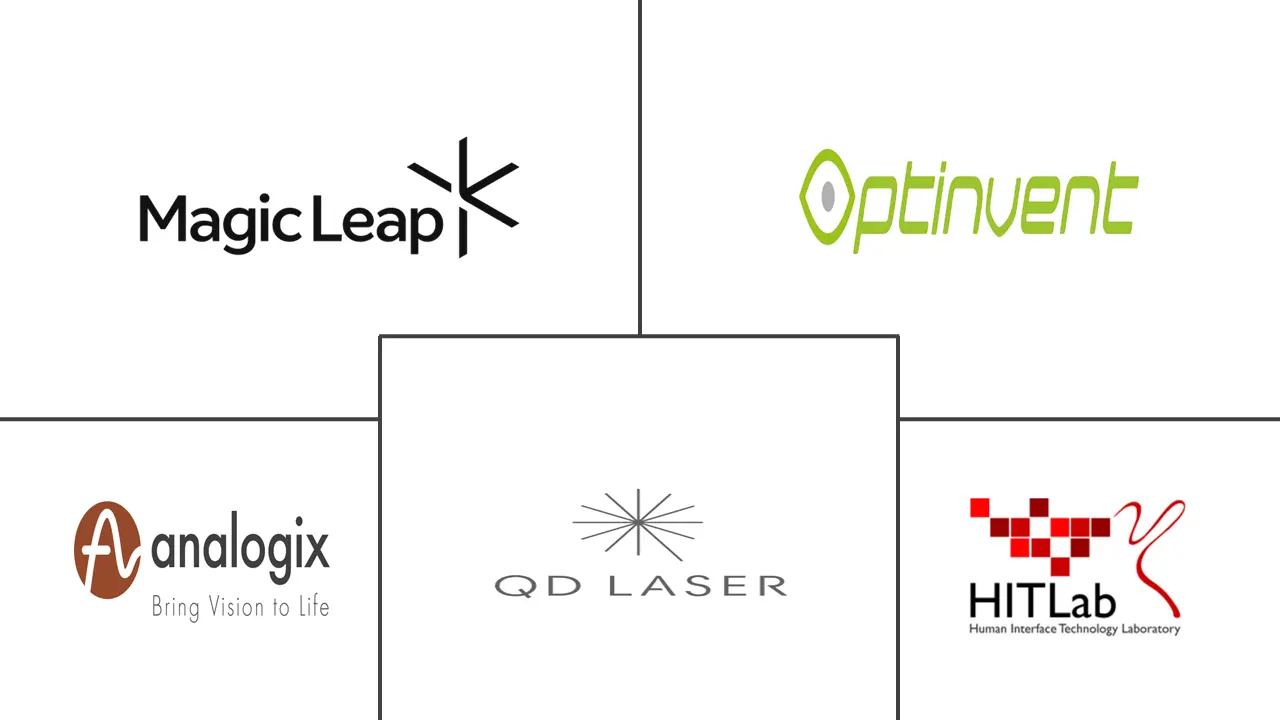
Virtual Retinal Display Market Analysis
The Virtual Retinal Display Market is expected to register a CAGR of 42.6% during the forecast period.
- The retina display is highly secure and safe compared to other displays. Using a retina display, the user can control the intensity of the display through his voice. The adoption of this technology is making people easy to work in any environment without any security or privacy issues.
- As the technology addresses the high eye strain caused by night vision goggles, the technology finds applications in the aerospace and defense sector. The applications are widespread in the healthcare sector and range from treating trauma to being used as an aid in cancer detection.
- The virtual retinal display is highly efficient concerning power consumption, requiring far less power than the postage-stamp LCD screens used commonly in today's mobile devices. The gaming & entertainment industry application is driving the demand for the virtual retinal display market because this industry has been an early adopter of the technology and the demand created for augmented reality and virtual reality applications by users.
- On the other hand, the need for more awareness about the virtual retinal display is expected to hamper the market's growth. The major problem with virtual retinal displays is they can cause motion sickness. These restraining factors are said to decline the market's growth.
- The COVID-19 pandemic is influencing society and the global economy. The closure of manufacturing facilities globally has resulted in a significant loss of revenue and business for the nations under lockdown. The pandemic has had a significant negative impact on the production and manufacturing processes. However, to fight COVID-19, companies have been actively investing in product development.
Virtual Retinal Display Market Trends
Virtual Reality and Augmented Reality are Gaining Surging Demand from the Entertainment Industry
- Virtual reality and augmented reality are gaining increasing demand from the entertainment industry. Augmented reality technology is mainly used in games and animations in the real world, using new retinal display systems. In the entertainment industry, eyewear glasses are used in 3D cinemas. However, in recent days, these are being replaced with smart glasses for improved cinema experience for the audience. Smart glasses are also being used for a virtual reality cinema experience.
- Avegant and Magic Leap have entered this segment due to high demand and purchasing propensity. Today's tech-savvy generation demands the most innovative gaming and media solutions and the most immersive experiences. As a result, terms such as 'personal theatre' have been coined by companies to commercialize various solutions.
- On the other hand, augmented reality games could reach a broader audience than those who play games because they can be played outside based on interaction with other people and augmented virtual objects. High contrast, high resolution, low power consumption, and high brightness are increasing the demand for virtual retinal displays, making them an ideal choice in various applications such as media and industry.
- According to FICCI, India's media and entertainment industry were valued at over INR 1.8 trillion (USD 22 Billion) in 2022. Virtual reality environments allow common people to engage with exhibits, concerts, museums, galleries, etc., in previously unknown and forbidden ways. It will enable the person to view 3D images, which appear life-sized to the person, making entertainment realistic and enjoyable.

North America to Witness Significant Growth
- The United States is one of the early adopters of virtual retinal display technology, and because of this, the North American segment dominates the market studied. In addition, the rapid demand for augmented and virtual reality in the region is expected to drive growth over the forecast period.
- Notably, owing to the exceptional benefits of the virtual retinal display, such as lightweight, larger angle of view, higher resolution, and sufficient contrast and brightness ratio, a few startups are raising funds to boost the R&D and commercialization of the product.
- The virtual retinal display is a next-gen technology for virtual and augmented reality, the companies operating in VR and AR have an immense opportunity to penetrate the market with early launches. However, the high price of the products may restrain the segment's growth.
- Like other technology enhancements, the virtual retinal display was developed for military use. The commander can view its onboard battlefield computer with a helmet-mounted daylight-readable display. And also, they can observe the surroundings better, choose the best path, and share tactical information.
- According to US Congressional Budget Office, spending in the Defense industry in the United States is predicted to increase yearly until 2032. In the United States, Defense outlays amounted to USD 760 Billion in 2022. The forecast estimates an increase in defense outlays of up to USD 998 Billion in 2032. Such increasing investments by governments in the defense industry are driving the demand for the virtual retinal display market.

Virtual Retinal Display Industry Overview
The Virtual Display Market is becoming highly competitive, with multiple vendors expanding their product line to offer a broad portfolio of solutions. Vendors have been rolling out virtual retina displays with numerous product improvements and an expanding array of built-in capabilities. In order to capture higher customer mindshare, they are competing on technologies, pricing, and product support. Key players in the market are Avegant Corporation, Magic Leap Inc., QD Laser Co. Ltd, Texas Instruments Inc., OmniVision Technologies Inc., Himax Technologies Inc., Movidius Inc. (Intel Corporation), Analogix Semiconductor Inc., and many more.
In October 2022, TDK Corporation displayed smart glasses equipped with the world's smallest class ultra-compact full-color laser module (FCLM) under development by TDK. The FCLM was used as a critical component in the smart glasses. Through joint development with QD Laser, Inc., which possesses unique laser direct retinal projection technologies, TDK created a demonstration sample of the smart glasses capable of laser direct retinal projection for both eyes and around double the viewing angle of previous products. The laser direct retinal projection method makes images visible regardless of the viewer's eyesight. In January 2022, Microsoft and Magic Leap collaborated and will make inroads in business with augmented reality glasses. Both companies are further along than individuals realize with AR glasses for specialized uses, especially in healthcare and manufacturing. AR has so much potential in the medical industry that healthcare companies are working hard to develop their headsets or create systems for Hololens or Magic Leap glasses.
Virtual Retinal Display Market Leaders
-
Magic Leap Inc.
-
Optivent
-
Analogix Semiconductor Inc.
-
QD Laser Co. Ltd
-
Human Interface Technology Laboratory
- *Disclaimer: Major Players sorted in no particular order

Virtual Retinal Display Market News
- December 2022: Meta confirms that it plans to bring a Retina-resolution VR headset to product maturity. Quest Pro has ten percent more PPD than Meta Quest 2, according to Meta (22 vs. 20 PPD). The PPD value takes the screen and the optics into account and measures the number of pixels within 1° of the field of view. For comparison, the Retina's 'resolution' is around 60 PPD, which is also the value Meta is aiming In the summer, display researchers presented the Butterscotch prototype, which achieves 55 PPD, but only has half the field of view of Meta Quest 2.
- December 2022: eMagin Corporation, a leader in developing, designing, and manufacturing high-resolution OLED microdisplays for AR/VR and other near-eye imaging products, announced its participation at the 10th International Congress on OCT and OCT Angiography. eMagin's displays offer a wide color gamut. High contrast, small form factors, and ultra-high resolution are ideal for medical applications. eMagin will demonstrate OLED microdisplays, including those used in ophthalmology applications like retinal surgery, imaging, diagnosis, and education, and suited for medical applications.
Virtual Retinal Display Industry Segmentation
A virtual retinal display (VRD) utilizes photon generation and manipulation to create a high-resolution, panoramic, color virtual image projected directly onto the human eye's retina without making a real or an aerial image viewed via a mirror or optics.
The Virtual Retinal Display Market is segmented by End-user Industry (Medical and Life sciences, Aerospace and Defense, Media and Entertainment) and Geography. The market sizes and forecasts are provided in terms of value (USD million) for all the above segments.
| By End-user Industry | Medical & Lifesciences |
| Aerospace and Defense | |
| Media and Entertainment | |
| Other End-user Verticals | |
| By Geography | North America |
| Europe | |
| Asia-Pacific | |
| Latin America | |
| Middle East & Africa |
Virtual Retinal Display Market Research FAQs
What is the current Virtual Retinal Display Market size?
The Virtual Retinal Display Market is projected to register a CAGR of 42.6% during the forecast period (2025-2030)
Who are the key players in Virtual Retinal Display Market?
Magic Leap Inc., Optivent, Analogix Semiconductor Inc., QD Laser Co. Ltd and Human Interface Technology Laboratory are the major companies operating in the Virtual Retinal Display Market.
Which is the fastest growing region in Virtual Retinal Display Market?
North America is estimated to grow at the highest CAGR over the forecast period (2025-2030).
Which region has the biggest share in Virtual Retinal Display Market?
In 2025, the North America accounts for the largest market share in Virtual Retinal Display Market.
What years does this Virtual Retinal Display Market cover?
The report covers the Virtual Retinal Display Market historical market size for years: 2019, 2020, 2021, 2022, 2023 and 2024. The report also forecasts the Virtual Retinal Display Market size for years: 2025, 2026, 2027, 2028, 2029 and 2030.
Our Best Selling Reports
Virtual Retinal Display Industry Report
Statistics for the 2025 Virtual Retinal Display market share, size and revenue growth rate, created by Mordor Intelligence™ Industry Reports. Virtual Retinal Display analysis includes a market forecast outlook for 2025 to 2030 and historical overview. Get a sample of this industry analysis as a free report PDF download.



